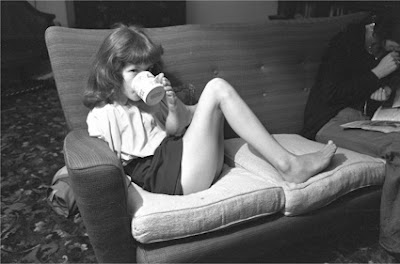I recently visited the Superhuman exhibition at the Wellcome Collection. It displayed a variety of objects and films, demonstrating how we have used technology and biology to enhance our lives...for centuries. Seemingly ordinary objects such as glasses, lipstick and an iphone were reminders that our lives are enhanced on a daily basis.
As we become more exposed to the 'rapid developments in areas such as nanotechnology, biotechnology and cognitive science' we are being increasingly confronted by the social and moral implications that they bring.This debate is highlighted at the beginning of the exhibition, through the story of Icarus. It reminds us that in our attempt to enhance ourselves we should also be aware of when to stop....Icarus flew too close to the sun, melting the wax that held his feather wings together.
The use of enhancement to 'normalize' the body appeared quite frequently, highlighting the impacts of societal demands on our development. A short film displayed the making of a glass eye, a protheses that 'completes' the body but cannot replace its function. An example of protheses that did try to encourage 'normal' functioning however, were the complex protheses made for the children affected by the thalidomide disaster. The artificial legs ans arms however, proved to hinder normal function rather than assist it. Many children preferred to adapt to their own bodies rather than adapting to social norms; demanding that society accepted them for who they were.
 |
| Philippa Verney Drinking Coffee with her Foot. Photograph by Frank Hermann |
I found it interesting to read the comments made by Aimee Mullins, a double amputee, paralympian and model. She was featured in Matthew Barney's Cremaster 3 film, which was on display in the exhibition. Mullins explained that society has progressed from the idea of trying to normalise the body and now considers the broader idea of augmentation and potential. Protheses are no longer seen as something to replace loss, rather that they 'stand as a symbol that the wearer has the power to create whatever it is that they want to create in that space, so that people society once considered to be disabled can now become the architects of their own bodies.' This notion of controlling the design of your body appearance links to the increasingly common act of cosmetic surgery. This was also discussed in the exhibition, in a film called 'Cut through the line' by Regina José Galindo, 2005. The increasing use of surgery to to achieve aesthetic perfection has allowed us to 'restructure our bodies to satisfy our own, or society's expectations.'
The exhibition also presented artistic interpretations of body enhancement, albeit cosmetic surgery could be considered art in the light of the performance artist Orlan. On display were items such as Vivienne Westwood's ghillie shoes and Rebecca Horn's material finger extensions titled 'Scratching both walls at once' 1974-75. The supporting words explained that Horn's 'delicate yet unsettling constructions extend the body, changing the relationship between the wearer and surrounding space.' The extension becomes a form of enhancement in that it brings things closer into touch. It increases the body's corporeal boundary and activates the space within it. The ability to move the extensions also serves to define and blur the boundary between the body and space. Horn uses many mediums to analyse the equilibrium between body and space/ object and space, such as spatial installations, sculpture and performance. Her early body extensions focus on the human in space, and her later works look at replacing the body with kinetic sculptures. More recently, Horn's work uses mirror reflections, light and music to define and cut through spaces. Westwood and Horn have interestingly both presented the idea of enhancement through extension, Westwood's 10 inch shoes highlight the hindrance this can cause.
The exhibition also presented artistic interpretations of body enhancement, albeit cosmetic surgery could be considered art in the light of the performance artist Orlan. On display were items such as Vivienne Westwood's ghillie shoes and Rebecca Horn's material finger extensions titled 'Scratching both walls at once' 1974-75. The supporting words explained that Horn's 'delicate yet unsettling constructions extend the body, changing the relationship between the wearer and surrounding space.' The extension becomes a form of enhancement in that it brings things closer into touch. It increases the body's corporeal boundary and activates the space within it. The ability to move the extensions also serves to define and blur the boundary between the body and space. Horn uses many mediums to analyse the equilibrium between body and space/ object and space, such as spatial installations, sculpture and performance. Her early body extensions focus on the human in space, and her later works look at replacing the body with kinetic sculptures. More recently, Horn's work uses mirror reflections, light and music to define and cut through spaces. Westwood and Horn have interestingly both presented the idea of enhancement through extension, Westwood's 10 inch shoes highlight the hindrance this can cause.
 |
| Rebecca Horn, Scratching Both Walls at Once, 1974-1975 |
 |
| Rebecca Horn, Scratching Both Walls at Once. |
 |
| Naomi Campbell falls in Westwood's 10 inch heel Ghillie shoes s/s 1993 catwalk |
Emily Sargent, the curator, explained that the range of objects in the exhibition were markers that enhancement should not viewed as an infringement on our 'core values' it is in fact 'our very desire to improve ourselves that makes us human'.
No comments:
Post a Comment